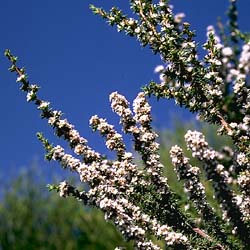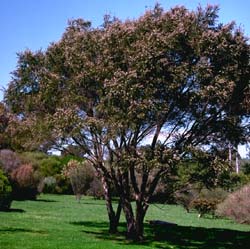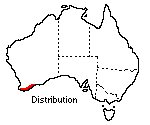Taxandria juniperina
Previously known as Agonis juniperina
 |
 |
Taxandria juniperina (Schauer) J.R.Wheeler & N.G.Marchant
Most gardens have a corner where a columnar-shaped plant is needed with some height, such as by a drive, between a house and fence or along the house walls. It may also be useful to have contrast among spreading forms in the shrub borders.
 Something
like a Cypress is the answer; but introduced conifers may be too big if fast-growing
or too slow if the right size and shape. For this purpose there is a Western
Australian native species, Taxandria juniperina (Agonis juniperina), which is better for several
reasons.
Something
like a Cypress is the answer; but introduced conifers may be too big if fast-growing
or too slow if the right size and shape. For this purpose there is a Western
Australian native species, Taxandria juniperina (Agonis juniperina), which is better for several
reasons.
It is a lightweight shrub under 7 m high in Canberra, though it can reach 13 m in some of its native habitats, and grows with exceptional speed, giving the quick cover desired in new gardens. It flowers for most of the year, except for a brief rest in summer heat.
When the leaves and young stems are bruised they release a lovely, spicy perfume from which the plant is recognised to be a member of the family Myrtaceae. It is closely related to Leptospermum (Tea Tree) and at least 11 Taxandria species are known, all restricted to Western Australia.
A major revision was published in 2007, changing the names of many previous Agonis species to several new genera, and leaving only 4 species in the genus Agonis.
Any soil and situation is suitable, but it keeps in better condition in light shade as it is slender and brittle with foliage easily drying out and falling if exposed to hot sun. The leaves are thin and narrow, about 1 cm long, and the general effect on a healthy plant is a dark, fresh green, neat rather than striking.
Of those tried in the Australian National Botanic Gardens, T. juniperina is the most vigorous and generally useful species and quite unaffected in the coldest winters. It withstands drought but is not at its best unless watered moderately.
To keep a compact and leafy column the shrub needs trimming lightly, possibly in late August or early September in Canberra or when resting around February. The natural development at about 3 m high is for the long thin branches to sway and spread to 1-2 m across near the top. In a plant of this type, growth is more towards the branch ends, and sparse in the lower few feet, revealing branches with light brown fibrous bark throughout.
Although the flowers are not showy, they are seen at a distance as upright whitish spikes at all levels of the shrub. It is at its best between March and June and often during winter, if watered. The tiny flowers resemble those of Leptospermum, and would be pure white but for a dark eye and a purple tinge at the base. They are stemless, in firm, round clusters at the tips of branches and many short, delicate laterals.
Some seed sets in Canberra. but cuttings are generally used for propagation and they root easily. The only pest has been slight scale in some years with the resultant smut fungus and, apart from trimming away lower dead growth, little attention is needed. The good practice of mulching would be beneficial, and drainage should be as good as possible.
Based on text by ANBG staff (1973)
Name meaning: Taxandria juniperina (Syn. Agonis juniperina)Taxandria - this genus name is derived from a botanical 'section' in George Bentham's 1867 treatment of the broad Agonis classification. He did not explain why he used that name for his section. There has been speculation that it relates to a region of southern Netherlands/northern Belgium called Toxandria or Taxandria by the Romans 'possibly' after the yew tree, Taxus. Agonis - from two Greek words meaning without angles, alluding to the softly drooping branches of other Agonis species, possibly Agonis flexuosa; juniperina - juniper-like. |
![An Australian Government Initiative [logo]](/images/austgovt_brown_90px.gif)

